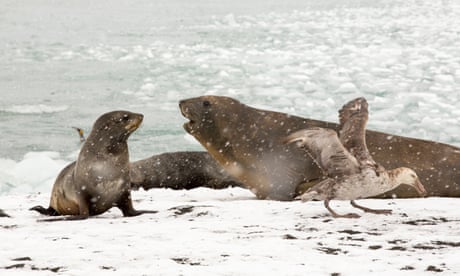Bird flu has reached Antarctica

At least one king penguin is suspected to have died from bird flu in the Antarctic. If confirmed, it will be the first of the species killed by the highly contagious H5N1 virus in the wild.
Researchers have previously raised alarm about “one of the largest ecological disasters of modern times” if bird flu reached remote Antarctic penguin populations. The birds are currently clustering together for breeding season, meaning the disease could rip through entire colonies if it continues to spread through the region.
King penguins are the world’s second-largest penguin, at about 3ft tall, and can live for more than 20 years in the wild. The suspected case was recorded on South Georgia island in the Antarctic region, according to the latest update from the Scientific Committee on Antarctic Research (Scar). A gentoo penguin was also suspected to have died from H5N1 at the same location.
Separately, at least one gentoo penguin has been confirmed to have died from H5N1 on the Falkland Islands – 900 miles (1,500km) west of South Georgia – with more than 20 chicks either dead or also showing symptoms. Since H5N1 arrived in the Antarctic, there have been mass deaths of elephant seals as well as increased deaths of fur seals, kelp gulls and brown skua in the region.
Previous outbreaks in South Africa, Chile and Argentina show penguins are susceptible to the disease. Since it arrived in South America, more than 500,000 seabirds have died of it, with penguins, pelicans and boobies among those most heavily affected.
Ed Hutchinson, a molecular virologist at the MRC-University of Glasgow Centre for Virus Research, said: “The arrival of this H5N1 virus in the Antarctic towards the end of last year rang alarm bells because of the risk it posed to wildlife in this fragile ecosystem. And while it is very sad to hear reports of penguins dying … it is unfortunately not at all surprising.”

Diana Bell, emeritus professor of conservation biology at the University of East Anglia, said she had feared something like this would happen. “I’m just devastated, really – as will everybody who cares about penguins and the Antarctic … Given their colonial social organisation, you’d just wonder how quickly it would go through the colonies.”
So far, there are no recorded cases on the Antarctic mainland, according to Scar mapping data, but this could be because there are so few people present to record possible fatalities. Avian flu adds to the pressures already faced in these pristine polar ecosystems – a study in 2018 warned that the climate crisis and overfishing meant Antarctica’s king penguins “could disappear” by the end of the century.
The disease is also ripping through wildlife populations in the Arctic. In December, it was confirmed that for the first time a polar bear had died of H5N1. As with penguins, it is possible that more bears have died unnoticed as they tend to live in remote places with few people.
Read also
Official Release – December 17th! Crop & Price Navigator 2026/27
Ukraine’s harvest nears completion: Total grain output exceeds 56 mln tons
Wheat heads for worst week since June on global oversupply
‘Soybean GPT’ lands South Korea’s agriculture ministry in awkward situation
Thailand purchases 65 thsd tons of Argentine feed wheat
Write to us
Our manager will contact you soon



